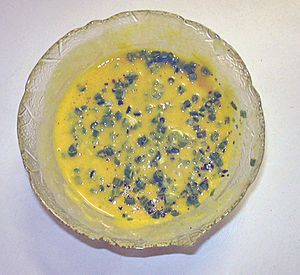Sauce facts for kids
In cooking, a sauce is a special liquid mixture. It is added to other food to make it taste better. Sauces are usually not eaten by themselves. They add flavor, moisture, and make a dish look more appealing. Sauces are a very important part of cooking all over the world.
For example, in French cuisine, many sauces start with a base called roux. A roux is just flour mixed with the liquid part of butter. In Italian cooking, you might find Carbonara, which has egg, cheese, and ham. There's also bolognese, a ground meat sauce, and pesto, made with herbs and garlic.
Some sauces come in bottles, like the tomato sauce you might pour over spaghetti. Gravy is a brown sauce often served with meat. The word sauce comes from the French word, which came from the Latin word salsus. This means salted. One of the oldest sauces ever recorded is garum. It was a fish sauce used by the Romans.
Sauces need to have a liquid part. But some sauces, like pico de gallo salsa or chutney, can have more solid pieces than liquid. Sauces can be used for savory dishes, like pasta, or for desserts, like fruit tarts. They can be prepared and served cold, such as mayonnaise. Some are made cold but served warm, like pesto. Others are cooked and served warm, like béchamel. And some are cooked and then served cold, like apple sauce.
Many sauces are products you buy in a store. Examples include Worcestershire sauce, HP sauce, soy sauce, or ketchup. In French cooking, chefs often make sauces fresh. Sauces used for salads are called salad dressing. A cook who is an expert at making sauces is called a saucier.
Famous French Sauces

Sauces have been a big part of French cuisine since the Middle Ages. There used to be hundreds of different sauces. They were a key part of French cooking in the 1800s and 1900s.
In the 1800s, a famous chef named Antonin Carême grouped sauces into four main families. He called these mother sauces or grandes sauces. Carême's four mother sauces were:
- Béchamel: This sauce is made with milk and thickened with a white roux.
- Espagnole: This one uses brown stock, usually from veal, and is thickened with a brown roux.
- Velouté: This sauce is made with white stock and thickened with a blonde roux.
- Allemande: This sauce is based on velouté sauce. It gets thicker with egg yolks and heavy cream.
Later, in the early 1900s, another famous chef named Auguste Escoffier updated this list. He named five mother sauces:
- Sauce Béchamel: A milk-based sauce, thickened with a white roux.
- Sauce Velouté: A white stock-based sauce, thickened with a roux or a special mix called a liaison.
- Sauce Tomate: A tomato-based sauce, thickened with a roux.
- Sauce Espagnole: Made from roasted veal stock, thickened with a brown roux.
- Sauce Hollandaise: This is a creamy mix of egg yolk, butter, and lemon juice or vinegar. Béarnaise sauce is a type of Hollandaise sauce, meaning it's a variation of it.
A sauce that is made from one of these mother sauces is sometimes called a small sauce or secondary sauce. Most sauces used in classic cooking are small sauces. They are made by adding more ingredients to a mother sauce. For example, Béchamel can become Mornay by adding Gruyère or other cheeses. Espagnole can become Bordelaise by adding red wine, shallots, and beef marrow.
Images for kids
-
Samosas served with four different sauces
-
A chef whisking a sauce
-
Tagliatelle pasta with Ragù alla Bolognese
-
A beef steak served with peppercorn sauce
See also
 In Spanish: Salsa (gastronomía) para niños
In Spanish: Salsa (gastronomía) para niños







